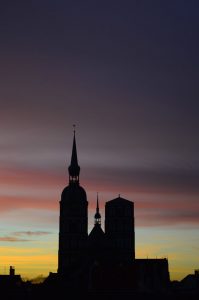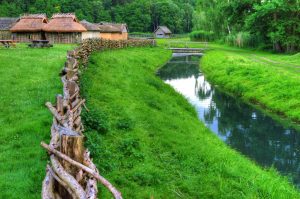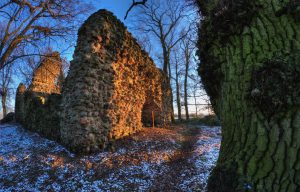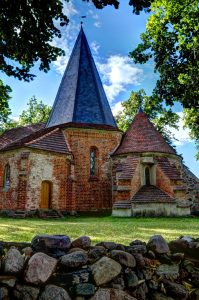
It is impossible to ignore the rich history surrounding Schloss Leizen, all around us are reminders of the region’s past. British Queens to the Ice Age there is always something to engage young peoples minds with the past as we venture out on trips, bike rides and hikes.
Germany For Kids at Schloss Leizen is in the Muritz region, part of the Mecklenburgische Seenplatte (Mecklenburg Lake District) within Mecklenburg Vorpommern (Mecklenburg & West Pomerania).
The area is famed for it’s natural beauty due mainly to the hundreds of lakes in the region which attract and maintain unique wildlife such as White Tailed Eagles, Ospreys, Cranes and even tree-frogs. Germany’s largest lake (entirely within it’s borders) the Muritz is only 5 miles away from Schloss Leizen.

The lake district and Leizen itself lies on the edge of what was a huge glacier during the ice age. The land around us was formed by the glacier and the evidence is everywhere, the small hills are in fact glacial drumlins and the lakes themselves are formed by morraine dams. Morraine being all the stones rocks and sand left as a glacier melts. To this day glacial rocks and boulders turn up in farmers fields, they travelled in the ice, which may have been up to 3km thick, all the way from Scandinavia more than 12,000 years ago and are used in many local buildings, including Schloss Leizen itself. Locally the smaler rocks are known as “Feldstein” and the larger boulders as “Findling”.

The original Germans, the Teutons, came to what is now Germany from Southern Scandinavia through Jutland (now Denmark) in the late Second Century occupying this region first before heading further south towards the Danube. This area has always been strategically significant and borders of states and countries have shifted often.
Evidence of ancient settlers is all around us, not only the Leizen “castle” but just a few hundred metres from our door ancient stone burial sites known as “Dolmens” can be found made from huge boulders in nearby woods these are maybe 3-5000 years old, just a little further and on our regular cycle route to the nearby historic town of Röbel is an ancient Schwedenschanze or Landwehr a fortified border formed of a deep ditch with long mounds either side. Read more about local Dolmens on our blog here.

Because of this strategic importance the region has had had many historically important noble families. The most significant member of such families was Sophie Charlotte of Mecklenburg Strelitz born in 1744 and raised in nearby Mirow she went on to become Queen of Great Britain and Ireland through her marriage to George the third of England in 1761. Many towns and streets around the world are named after her shortened name “Charlotte”, the world famous Buckingham Palace was bought for her residence and she was the grandmother of Queen Victoria. George the third, unfortunately, is most famous for his madness. Read more about Queen Chartlotte on our blog here.
Mecklenburg therefore is famous for the abundance of castles, stately homes and manor houses, many of which can be visited and the Schloss where Queen Charlotte was raised and the grandest examples in Schwerin and Gustrow form part of our programme of regional trips.
Update: we have a more detailed history of Schloss Leizen itself here.
Some noteable dates in Mecklenburg History:
- 10,000-100BC: Land occupied by ancient people primarily Celts who settled after the Ice Age and left many ancient Dolmens for which the area is famous.
- 100BC Germanic people arrive
- 600AD Germanic people leave and the area is populated by Slavic people, building the first castles Slavic influence remains until this day in town names such as “Schwerin”
- Late 1100s Henry the Lion Duke of the Saxons conquered the area, Germanic people return along with Flemings
- Mid 1200s the Hanseatic league is formed. An internationally important agreement between Independent Baltic cities, boosting the wealth and importance of the area and generating prosperous and beautiful cities such as Stralsund, Wismar, Greifswald and Rostock.
- 1348 Mecklenburg becomes a Duchy of the Holy Roman Empire
- Rostock (1419) and Greifswald (1456) Universities are formed, amongst the oldest universities in the world and still educating to this day.
- 1870 Mecklenburg and Pomerania join the German Empire
- 1918 Monarchies of Mecklenburg abolished and it becomes a Republic
- 1944 the First rocket to reach outer space was launched from Peenmunde
- 1949 MV becomes a state of the GDR
- 1990 German Re-unifcation MV retains its 1952 boundaries
- 2013 After two decades of growth service, tourism and tech industries net migration becomes positive
